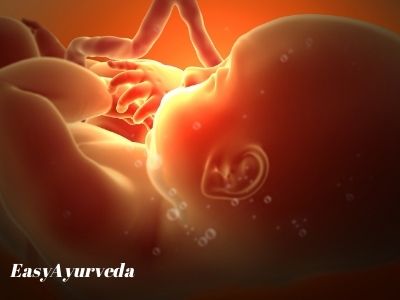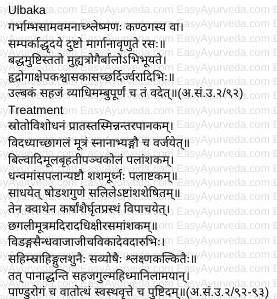Aspiration in Newborn – Ulbaka – Causes, Symptoms, Treatment
By Dr Raghuram Y.S. MD (Ay) & Dr Manasa, B.A.M.S
Ulbaka is a disease which occurs in the newborn child. This probably is an explanation of a condition wherein the infant swallows’ garbhodaka i.e. liquor ammi which blocks the throat of the child. It can be compared to ‘aspiration in newborn child’ or ‘aspiration pneumonia in newborn child’.
Other names –
- Sahaja vyadhi – Disease with which the child is born with
- Ambupurna vyadhi – Disease caused due to aspiration of fluid.
Read – Classification of Vyadhi (diseases) according to Ayurveda
Table of Contents
1. Etiology
Improper emesis of garbhodaka – liquor ammi. Soon after birth, the child is made to vomit. If this procedure is not followed properly, it can cause aspiration.
Contact of kapha located in the throat of the child with the heart (Kapha aggravation in the chest region).

2. Pathogenesis
Due to one or more of the above said causes, the rasa tissue gets vitiated. Following this the rasa obstructs the channels of pranavaha srotas – respiratory passages or channels of transportation of prana, the vital air needed for life processes.
3. Symptoms
- Baddha mushti – the fists of the child gets tightened
- Hrdroga – heart disorders
- Akshepaka – convulsions
- Shwasa – dyspnea
- Kasa – cough
- Chardi – vomiting
- Jwara – fever and other disorders
4. Treatment
Early in the morning goats urine should be given to drink so as to cause cleansing of the body channels. It should be administered in between the breast feeds.
Snana Abhyangau Varjayet – Massage and bath should not be given to the child.
Bilwadi Panchamula Siddha Ghrta
The ghee prepared with below mentioned ingredients is given for oral consumption –
1. 1 pala (48 grams) each of –
a. Bilvadi Panchamula
- Bilva – Aegle marmelos
- Agnimantha – Clerodendrum phlomidis
- Syonaka – Oroxylum indicum
- Patala – Stereospermum suaveolens
- Gambhari – Gmelina arborea
b. Brhati – Solanum indicum
c. Panchakola
- Pippali – Piper longum
- Pippalimula – roots of Piper longum
- Chavya – Piper retrofractum
- Chitraka – Plumbago zeylanica
- Nagara – Zingiber officinale
Read – Child Afflicted With Putana Graha And Sheeta Putana Graha
2. Eight pala (384 grams) each of –
- Dhanva mamsa – meat of wild animals
- Shasha murdni – head of rabbit
The above said ingredients should be cooked in 16 times water. When half of it remains it should be filtered.
3. To this decoction the each of the below mentioned should be mixed in a quantity equal to that of decoction –
- Goat urine
- Wine
- Curds
- Milk
4. Also 1 karsha (12 grams) each of the below mentioned should be added to the decoction –
- Vidanga – Embelia ribes
- Saindhava – rock salt
- Ajaji – Cuminum cyminum
- Chavika – Piper retrofractum
- Devadaru – Cedrus deodara
- Himsra – Capparis sepiaria
- Hingu – Ferula narthex
- Lashuna – Alium sativum
- Vyosha – Piper longum, Piper nigrum and Zingiber officinale
Read – Symptoms That Hint Towards Different Diseases In Babies
5. 1 prastha Ghrta – With this mixture, 1 prastha (768 grams) of ghee should be cooked following the standard procedure of processing ghee medication.
Medicinal benefits of the formulation
This ghee when regularly consumed orally would cure –
- Ulbaka – swallowing of liquor ammi leading to choking of throat and other consequences
- Gulma – abdominal tumors
- Hidhma – hiccough
- Vata rogas – disorders of vata origin
- Vataja Pandu – anemia caused by predominant vitiation of vata
This ghee also gives strength and nourishment even to a healthy child.
Sanskrit Verses

Probable Modern Correlation
In a newborn child the throat is covered with mucus right at birth. This mucus is cleaned and removed immediately after delivery of the child. Sometimes this mucus or liquor amnii or both may be inhaled by the child. This would produce aspiration pneumonia. Probably ulbaka is a description of this condition.
This condition is also compared to MAS – Meconium Aspiration Syndrome.
Read – Child Afflicted With Revati Graha And Shushkarevati Graha
Meconium aspiration syndrome (MAS)
In this condition the newborn baby breathes in a mixture of meconium and amniotic fluid.
It is a condition in which there is aspiration of stained amniotic fluid. It can occur before, during or immediately after birth of the child.
Meconium is a viscous, dark green substance. It is the first intestinal discharge from newborns and consists of intestinal epithelial cells, mucus and intestinal secretions. About 90% of it is made up of water and solids form the other 10-15% of it.
Meconium aspiration occurs when a newborn child breathes a mixture of meconium and amniotic fluid. Amniotic fluid or liquor amnii is the liquid that surrounds the baby in the womb. Meconium is the baby’s first stool which appears dark green, is thick and sticky in consistency.
This condition occurs only in small number of births. It is common in babies born full term but are small for gestational age. It is also common in post term babies (born after 42 weeks).
Symptoms
- Meconium staining – greenish color of amniotic fluid due to getting stained by meconium
- Yellow / bluish skin and nails
- Rapid breathing with grunting sounds
- Enlarged / bloated chest due to trapped air in lungs
- Intercostals muscles are pulled inwards as the child breathes
Read – Child Seized By Pitru And Shakuni Graha – Symptoms, Treatment
Diagnosis
Amniotic fluid is checked for presence of meconium at child birth
Chest X-ray may be recommended
Treatment
Treatment is based on one or more of the below mentioned factors –
- Amount of meconium
- Thickness of meconium
- Duration of complaints
- Pattern of breathing and the extent to which it is disturbed
Treatment principles at birth –
- Suction of upper airways
- Suction of lower airways through endotracheal tube placed in the windpipe
- Oxygen administered through ventilator or face mask
Read – Dyspnoea – Difficulty in breathing: Causes, Pathophysiology, Diagnosis
Possible complications
Breathlessness and air trap – Bits and pieces of meconium can enter the airway when the babies take their first breaths at birth. Later they may also be inhaled into the lungs and may even stick to the alveoli (air sacs in the lungs). This makes breathing and taking in oxygen difficult for the baby and may also trap air in the baby’s lungs.
Pneumonia – is an infection which may be caused by this condition. Severe cases may even lead to death but most babies will get better within few days.
Prevention
Amnioinfusion – is a procedure used during labor if there is evidence of presence of meconium stained amniotic fluid. Here a small tube is inserted into the uterus through vagina. Sterile fluid is introduced into the uterus through it so that the thick meconium thins out.
Click to Consult Dr Raghuram Y.S. MD (Ayu) – Skype









